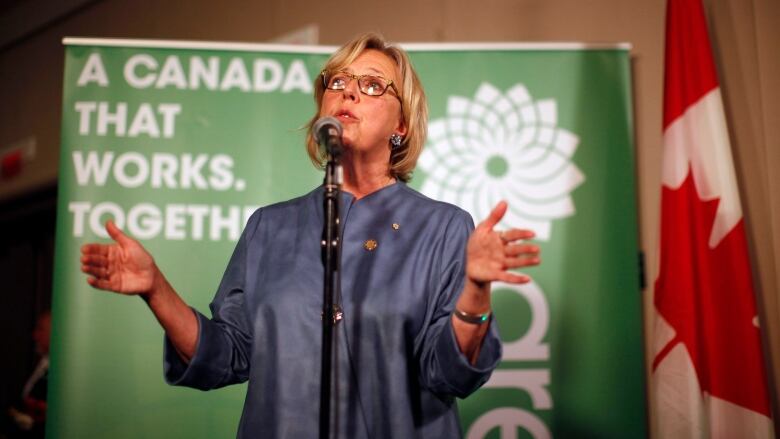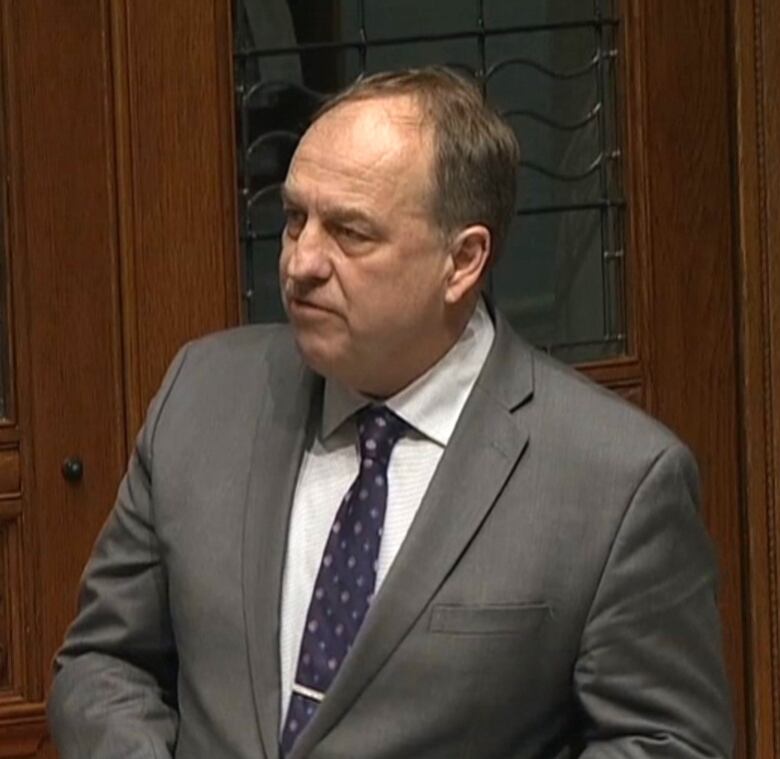Is the Green Party ready for life after Elizabeth May?
Popular leader will leave mixed legacy

If Elizabeth May is the Green Party, what wouldbecome of the Green Party without Elizabeth May?
This is a question that might need to be answered soon. In an interview onCBC Radio'sThe House, May told host David Cochranethat she could resign as leader of the Green Party within the month. She's taking the time offered by a family vacation to think it over.
- Elizabeth May could quit as Green Party leader this month
- Listen to CBC Radio's The House
- Leader Meter: Check out the latestleaders' approval ratings
This reflection has been sparked by the party's adoption of the Boycott, Divestment and Sanctions (BDS) movement at a policy convention last weekend. Opposed by the Green Party leader, this movement urges economic pressure against Israel as a response to what it considersthe Jewish state'soppression of Palestinians.
With May as its leader since 2006 and its sole member of Parliament, the Green Party has become largely synonymous with May. Her departure, considering her largely positive national profile, could be a tremendous blow to the party.
But May isn't the only elected Green politician in Canada. Greens also sit in the provincial legislatures in British Columbia, New Brunswick and Prince Edward Island. The results of the last election suggest that May is still a net asset for the Greens but that the roots that have been planted by these provincial Greens may start bearing fruit.
May carries party where provincial Greens don't
The Green Party captured a larger share of the vote in the 2015 federal election than its provincial counterparts did in their most recent elections in Alberta, Saskatchewan, Quebec, Nova Scotia and Newfoundland and Labrador (where there is no provincial Green Party). The federal Greens also did better than the B.C. Greens, though by just a tenth of a percentage point.
This might suggest that May draws more votes than the Green brand in these provinces. But these provinces also happen to be ones where the provincial Green Party has no elected members and is not considered significant enough to warrant a place in the debates.

Provincial Greens, however, did better than their federal counterparts in provinces where they were successful in electing a candidate and/or having their leaders in the debate: Manitoba, New Brunswick and P.E.I., as well as B.C.
(Ontario, where the provincial Greens did better than the federal Greens,could be a bit of an outlier due to the unpopularity of the three main leaders during the last provincial election.)
Provincial Greens are also polling better than the federal party in these provinces.This could be an indication that Greens are able to carry their own weight without the help of Maywhere they have managed to buildsome infrastructure and a brand that is separate from May.
May still best known Green in Canada
But despite the experience of a few provincial Greens, May remains the party's most familiar face by far as well as one of Canada's more popular politicians.
In three polls conducted in 2016, May has averaged an approval rating of 50 per cent. Just 33 per cent of Canadians, on average, disapprove of her. This net +17 rating compares favourably to those of interim Conservative Party Leader Rona Ambrose (+4) and NDP Leader Tom Mulcair (-5) recorded in the same polls.

Just 17 per cent of Canadians said they did not have an opinion of May. That is far lower than the ratings for some provincial Green leaders. Between 48 and 54 per cent of respondents in their home provinces had no opinions of Saskatchewan Green Leader Victor Lau, Manitoba Green Leader James Beddome and B.C. Green Leader Andrew Weaver.
But that doesn't mean a Green leader who isn't Elizabeth May cannot impose themselves on the political landscape.Since the 2015 provincial election, P.E.I. Green Leader Peter Bevan-Baker has been the choice as the best person to be premier of the province by an average of 25 per cent of Islanders, putting him just 13 points behind the actual premier.
May's Green legacy mixed?
Though May has given the party a popular spokesperson and a seat in Parliament, just how effective has she really been?
The days when the Greens were polling in double-digits are long behind them. Throughout 2010 and the beginning of 2011, the Greens routinely scored between 10 and 12 per cent in the polls. After five years, the party has not been able to replicate that. It currently polls at around five per cent support.
That is still more than what the party captured in the last election. After taking 6.8 per cent in May's first election in 2008, her party's vote shareslid to 3.9 per cent in 2011 and to 3.4 per centin 2015, its lowest share since the party first ran a full slate of candidates in 2004.

Support in Alberta, which stood between five and nine per cent between 2004 and 2011, dropped to just 2.5 per cent in 2015. Ontario, which used to vote for the Greens in larger proportions than the rest of the country, did the opposite last October. And the only other Green candidates who came anywhere close to being elected last fall were those in ridings adjacent to May's.
So the legacy of May's tenure as leader ismixed, and the ranks of her potential replacements are thin. The three currently elected MLAs (Weaver, Bevan-Baker and David Coon in New Brunswick) are all party leaders, and making the jump to the federal scene would put their fragile toeholds at the provincial level at risk.
The adoption of the BDS movement as official Green policy has put the party in a precarious position at a delicate time. It could cost the Greens their biggest asset. It might also make it difficult to attract a figure from outside the party with a national profile to take on the job. The policy itself, or the instability it might cause, could put cracks in the foundations being laid at the provincial level.
And all this at a time when the Green Party could be on the cusp of something that would substantially transform its role in Canadian politics electoral reform.
It's a lot for May to think about. Some vacation!
- The Pollcast: Subscribe to ric Grenier's podcast












_(720p).jpg)


 OFFICIAL HD MUSIC VIDEO.jpg)
.jpg)



























































































